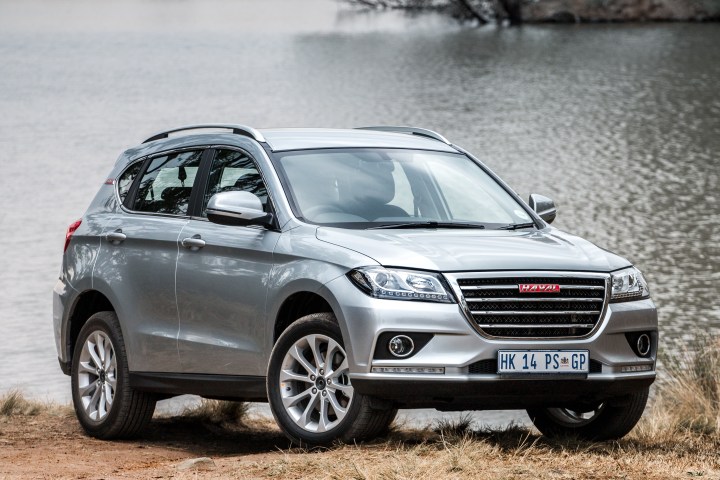MOTORING
Haval H2 City Manual: Playing the catch-up game

With a reputation based on cheap pricing and sometimes questionable quality, it’s not surprising that Chinese vehicles haven’t found a foothold in the South African market. However, the Haval brand is proof that the Chinese are upping the stakes.
The Haval brand might not be as top-of-mind as mainstream auto marques such as Toyota, Ford and Volkswagen. But the Chinese company is fast gaining ground in a market widely considered one of the world’s most competitive.

Image supplied.
Shiny new dealerships and a line-up of equally shiny and appealing vehicles have started attracting attention to the Haval badge. More importantly, they’re becoming increasingly prevalent on our roads.
Recognising that the sports utility vehicle (SUV) market is where the action is, the Haval line-up consists solely of SUV models, starting with the compact H1, and progressing through the H2 and H6 to the large and luxurious H9.
Haval is the premium arm of GWM (or Great Wall Motors), which has been active in South Africa for some years. While GWM’s focus is now primarily on the bakkie segment, Haval is seeking a more elevated status – and greater public acceptance.

Image supplied.
The H2 City tested here is one of the brand’s more affordable offerings in a line-up already emphasising value for money. But don’t get me wrong: the H2 is not a stripped out, bargain-basement, cheap and nasty machine.
Instead, it’s a well-proportioned and surprisingly well equipped compact SUV that looks bigger and beefier than its natural rivals. Those rivals include the Renault Captur, Opel’s Crossland and the Ford Ecosport.
The H2’s aesthetic approach could be considered a little generic – but then, that’s true of many other players in this segment. And to be fair, there’s not a huge amount of scope for adventurous design in the classic SUV context.

Image supplied.
No wonder then that the H2’s front end is dominated by a large, chrome-straked grille, adorned with a bold, red Haval logo in an effort to underline its identity. Clear-lensed headlights, neatly recessed fog lamps and LED daytime running lights all to add to the visual interest, while the integrated front bumper even gets a sporty lower lip.
The rear is tidy, with chrome garnish strips adding some definition, and a roof spoiler continuing the mildly sporty theme. Dual exhausts jut out from a rear scuff plate finished in contrasting black, a theme continued by the sill protectors along the H2’s sides.

Image supplied.
In profile, the high waistline, relatively narrow glass aperture and sculpted flanks create a poised impression, while roof rails and a raised stance emphasise the Haval’s SUV aspirations. Handsome 18-inch alloy wheels are standard.
The overall impression is smart, if not particularly charismatic. And close up, there’s nothing to complain about in build quality terms, either: the shut lines are even, the paintwork glossy and the doors open and close with positive precision. It all adds up to a well-executed package.

Image supplied.
The interior continues that theme – and if you expected the entry-level H2 City model tested here to be short of features, you’ll be pleasantly surprised. This is a cabin stocked with loads of kit, linked to decent ergonomics and pleasing finishes.
The dark cloth upholstery looks and feels both comfy and durable, the switchgear is reassuringly robust, and the plastics are smart. For some, the faux metal surfaces – especially the vast expanse on the dashboard – may be a bit garish, but then, that’s very much a matter of personal taste.
The equipment list is impressive, especially considering a price tag some R40,000 shy of the R300,000 mark. Electric windows and mirrors, manual air-con, remote central locking with keyless entry and a start button, cruise control, and a four-speaker CD tuner-based sound system with Bluetooth, USB, and a 3.5mm input socket are all standard.

Image supplied.
A clear set of analogue dials are augmented by a digital trip computer offering a raft of information on fuel consumption, range, trip distance and more. Admittedly, the polyurethane steering wheel could be grippier (and feels a little low rent), but it does offer a set of multifunction controls.
Front accommodation is comfortable, thanks to multi-adjustable bucket seats, but you’re reminded that the H2 is a compact SUV by rear seating that while adequate, isn’t exactly in the stretch-out league. At 300 litres, the boot could be bigger, too.

Image supplied.
Safety remains a key consideration among new car buyers, and the H2 City does address that need with dual front airbags, ABS-controlled brakes, child locks, and tyre pressure monitoring. There’s also rear park distance control.
However, opt for the more expensive H2 Luxury model, and you get an additional four airbags (side and curtain), as well as electronic stability control and a reverse camera. For some, the extra R25k might be worth it just for the added peace of mind.

Image supplied.
Arguably the H2’s weakest link is the drivetrain, and specifically the engine. It’s a turbocharged 1.5-litre petrol unit, linked here to a six-speed manual gearbox, and powering the front wheels.
The on-paper specs are encouraging, promising 105kW of muscle and a smidgen more than 200Nm of torque. However, the real-world delivery is compromised by low-down turbo lag that requires some circumspect use of clutch and throttle to overcome.

Image supplied.
You do get used to it, and it also has to be said that the lag will be more prevalent at Johannesburg’s elevated altitudes. But Haval would do well to smooth out the peakiness to make the power delivery more accessible and user-friendly.
It’s also not the most refined of drivetrains, with a gruffness creeping in at the higher revs necessary to make the most of the available urge.
Once on the move, there’s ample pep, and the shift action of the manual gearbox is positive enough, albeit requiring some intent – no snap changes, here! I’d be tempted to suggest that the dual-clutch auto on offer for an extra R10,000 or so might be a better all-round choice.

Image supplied.
The H2 handles both town and country roads with confidence – and while the drivetrain lacks some polish, ride quality is good, with a set-up that finds a convincing compromise between comfort and composure.
Despite its compact dimensions and relatively short wheelbase, it irons out bumps and dips, but never feels soggy. Predictably, the steering places the emphasis on assistance rather than feedback, but the H2 heeds the helm’s commands smartly enough.

Image supplied.
With 180mm of ground clearance on offer, the H2 is more crossover than SUV when heading off the beaten track, also confirmed by those relatively low-profile tyres. But it’s more than capable on decent gravel roads, and the dust-proofing is admirable – further confirmation of the Haval’s build quality.
That visual and tactile attention to quality is at the very heart of the Haval H2’s appeal – it instantly addresses any concern that this just another cheap Chinese import. Plus, you get an extensive list of standard equipment, at a price that reflects exceptional value.
Drivetrain apart, the H2 City compares very favourably with most of its rivals from more fancied brands.

Image supplied.
On that subject, it’s worth remembering there was a time when Korean marques were considered inferior. Now, they’re right up there with the best Europe and Japan can offer. Indeed, back in the 1960s and early 1970s, there was a similar indifference to Japanese marques.
Haval is proof that the Chinese are catching up – and catching up fast. DM
PROS
Convincing execution inside and out. Feels reassuringly solid, too. Keen pricing and comprehensive spec translate into compelling value.
CONS
Doesn’t enjoy the same brand equity as better-known marques – yet. Turbo lag compromises dynamics, especially at Reef altitudes.
VITAL STATS
|
Haval H2 City MT |
|
|
Engine |
In-line four-cylinder, 1,497cc, turbo petrol |
|
Power |
105kW @ 5,600rpm |
|
Torque |
202Nm @ 2,200rpm |
|
Power-to-weight ratio |
70,23 kW/ton |
|
Gearbox |
Six-speed manual, FWD |
|
Wheels/tyres |
18-inch alloy, 235/55 R18 tyres |
|
0-100 km/h |
13sec (est.) |
|
Top speed |
190km/h |
|
Fuel tank capacity |
57 litres |
|
Fuel consumption (claimed/tested) |
8.2/9.7 litres/100km |
|
Operating range (claimed/tested) |
695/588km |
|
CO2 emissions |
194g/km |
|
Retail price / as tested |
R259,900 |
|
Warranty |
5 years/100,000km |
|
Service/maintenance plan |
5 years/60,000km |

















 Become an Insider
Become an Insider